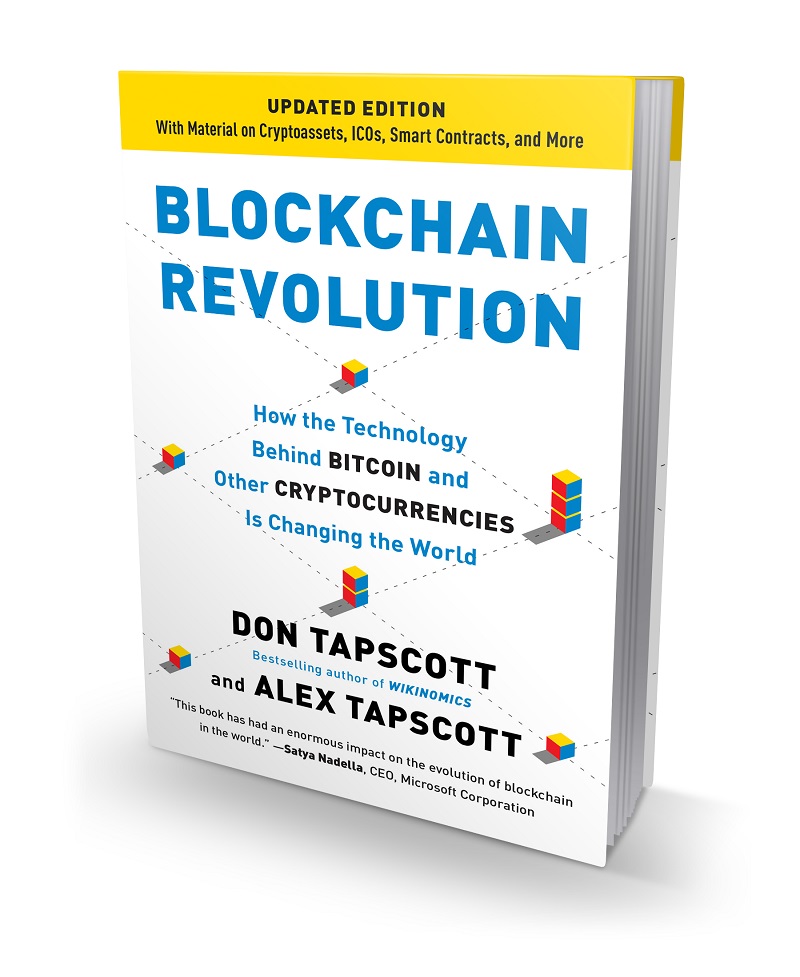Punditry runs in this family. Don Tapscott has been writing about business strategy for decades, doing everything from pontificating about Wikinomics to giving Ted Talks about the future of money. And now his son, Alex Tapscott, has joined the family business as a speaker, investor, writer, and adviser on emerging technologies. The younger Tapscott’s own Tedx Talk on blockchain has been viewed more than 630,000 times.
The Tapscotts are excited about the revolutionary potential of blockchain. It’s a 2018 phenomenon, but they are certainly not late to the party. In 2016, they coauthored The Blockchain Revolution: How the Technology Behind Bitcoin Is Changing Money, Business, and the World. The book has been a bestseller in a few countries and has been translated into 18 languages. Now it has been updated in its paperback edition, which hit the streets in June. It’s all about how decentralized cryptocurrencies, bolstered by the security and transparency of blockchain, could disrupt all sorts of traditional businesses, including banks.
“The success of the book internationally reflects the global nature of this whole industry. This is not something where all the value and innovation is being created in Silicon Valley. It’s not like the early ’90s. The technology is global, and the phenomenon is global as well,” said Alex Tapscott, in an interview with VentureBeat.
In 2017, Alex Tapscott and his father cofounded the Blockchain Research Institute, a multi-million-dollar think tank that is investigating blockchain strategies, opportunities, and use cases. I talked with Alex Tapscott about what has changed in the past few years and where blockchain is heading.
June 5th: The AI Audit in NYC
Join us next week in NYC to engage with top executive leaders, delving into strategies for auditing AI models to ensure fairness, optimal performance, and ethical compliance across diverse organizations. Secure your attendance for this exclusive invite-only event.
Here’s an edited transcript of our interview.

Above: The Blockchain Revolution by Don Tapscott and Alex Tapscott.
VentureBeat: You’ve been paying attention blockchain for a while. The book came out in 2016, right?
Alex Tapscott: Yeah, the first edition of the book was May 2016.
VentureBeat: You updated it for the paperback here?
Tapscott: When the book came out, the world was much different than it is today. We felt there was a need to update on what had happened in the last couple of years. But I will say the book ended up holding up really well, when we went back and reviewed all the core ideas we wrote about.
VentureBeat: It seems like it was good to be in on this early, or at least early in the first round of the craze.
Tapscott: It was certainly good timing. It’s better to be lucky than smart, they say. When the book came out, it was right around the time that this was transitioning from a small and passionate community of users and technologists was interested in to something that the world at large was becoming interested in. People began to appreciate the implications for the technology, beyond Bitcoin and cryptocurrency, although that’s still an enormous part of the space.
VentureBeat: How would you summarize what’s changed from 2016 to 2018?
Tapscott: A lot has changed, but the one thing that’s really changed is the proliferation in the asset class itself. When the book came out, the value of all crypto assets combined was around $10 billion. Put another way, that would be the smallest constituent of the S&P 500 index. Fast forward to today, [when] despite the volatility we’ve seen, the value of the market is more than $250 billion, which is bigger than most large companies, though obviously still small compared to other asset classes.
The big thing that’s caught a lot of attention in the past couple of years is the growth in so-called ICOs, token fundraising. We’ve seen the value of these raises increase pretty significantly. In 2015 the value was in the $5-10 million range. In 2016 it was around $165 million, and most of it was one particular financing called the DAO. But if you look at last year, it was around $5 billion, and this year to date it’s around $10 billion.
It’s begun to have a profound impact on the world of venture capital in terms of how entrepreneurs access funds to grow and start a business, but also, it’s changed the nature of how companies organize. These new entities look a lot more like networks than they do traditional companies and traditional organizations.
What we did for the book, to help summarize this, was to create a taxonomy for crypto assets. What are all these things? Why do they matter? Why are they valuable? Where is the whole space going? Or at least our best answers to that. We ended up defining or identifying seven different types of crypto assets, which we talk about in the book.
The seven types are, one, cryptocurrencies like Bitcoin; two, protocol tokens, like Ethereum; three, app coins or utility tokens, tokens specific to applications that could be doing any number of things; four, so-called security tokens, digital versions of financial assets; five, natural asset tokens, digital assets that have a connection to an asset in the real world, like a barrel of oil; six, cryptocollectibles, unique digital assets; and finally, seven, crypto-fiat currencies, digital assets being created by governments.
VentureBeat: At this point do we have a handle on where the bulk of the startups are, the companies in this space?
Tapscott: Most of the startups that have done these things in the past year and a half have launched what’s called a utility token. Most of those utility tokens have been launched on one platform, Ethereum. Ethereum, I think a lot of people confuse it with Bitcoin, as another currency. It isn’t really a currency. The token is a way for paying for usage of the network. All of these applications are built on the Ethereum network, and the more applications that are built, the more funds get raised, the more demand there is for the underlying token, Ether. But each of these individual apps also have their own token.
If you look at the number of projects that have raised money over the last year and a half, it’s been at the utility token level. If you look at where most of the value has been captured, the vast majority is still in categories one and two. To this day, more than 40 percent, almost half the value of all crypto, is still Bitcoin.
My perspective personally is that Bitcoin currencies are a great use case for digital assets. It’s a way to move and store value peer to peer. It can act like gold, as a store of value that’s fungible, meaning you can spend it and send it. It’s a way to pay for goods and services. All of those things give it utility and make it super valuable. I think Bitcoin is going to continue to grow and become more important.
But in turn, a lot of value is going to be captured in that second category. We’re already seeing that with projects like Ethereum, where Ethereum can be more than just one thing. It’s general purpose. It can run lots of applications. We’ve seen games and casino applications and betting networks and marketplaces and shared economy companies. All sorts of different business models that try to connect buyers and sellers, different individuals, in a way that’s peer-to-peer without central intermediaries. There are lots of use cases for that.
A lot of the value will continue to migrate long term away from cryptocurrencies and into these protocol currencies. Eventually the apps will become valuable. But if you look at today, most of the apps are not commercial, meaning they haven’t really launched. A lot of that has to do with some specific bottlenecks at the protocol level. Until the protocols themselves are super fast and powerful, the apps will be limited.
A good analogy would be, say, somebody launched a video streaming application in 1993. It’s a great idea. Netflix ultimately came to dominate that. But at the time, the underlying technology could barely process language and imagery, let alone high-definition video. A lot of these concepts are ideas whose time, basically, has not come yet. Eventually as the technology scales and becomes better, the apps will become more valuable.
VentureBeat: A lot of the concern in the space has been around fraud related to some ICOs. I remember the Wall Street Journal earlier this year, they looked at 1,450 ICOs and found fraud problems with nearly 300 of them. How do people come to terms with that challenge?
Tapscott: Fraud in the space is a big problem. It’s important to differentiate between two things. There are projects that don’t succeed, because the idea is flawed or the execution is flawed or any number of reasons. And then there are projects that are outright fraud. Lots of startups fail. Just because they fail doesn’t mean they weren’t well-intentioned. Many of the projects we’ve seen fall into that category. But a certain number fall into the fraud category.
The reason that these have been allowed to proliferate — or not allowed to, but have been able to – is because the market itself is still very new. There isn’t a lot of self-regulation or oversight. Most of the participants are what would traditionally be called retail. They’re individuals, not institutions. Regulators are not particularly — at least historically, they have not had an active hand in this marketplace.
My perspective is that this is, in many ways, a new asset class, a new asset category, and there’s lots of opportunities for innovation. But that doesn’t mean that, just because it’s a new and innovative area, there shouldn’t be sensible oversight and regulation. There are lots of existing laws that deal with things like market manipulation or Ponzi schemes and so on. Those rules should be applied vigorously to this marketplace in order to cut down on that fraud. When that happens, the marketplace will be much more vibrant and will be able to sustain more growth in the long term.
In terms of innovation and regulation writ large, that’s a more complicated question. Criminal activity, it’s easy to say that we want to stop that and it should be stopped. But there are lots of ways in which this technology transcends or conflicts with the current rules. Specifically, are these different token offerings securities offerings, or are they something else? I think many of them would fit the bill of a securities offering, but some might not. Being able to differentiate between those is a central challenge.
To their credit, a lot of regulators at the SEC have done a terrific job of working to understand this, talking to people in the industry. They’ve been vigorous when they see wrongdoing, and that’s fine. They’ve been open-minded when the questions are more complex. But figuring out the answers to this is going to be a tough one, and I think it will require a multi-stakeholder approach, where industry, regulators, and other stakeholders have a voice and are able to articulate their opinions.
VentureBeat: As far as the generation of technology, I’m coming across more pitches from startups that are going to make blockchain both secure and fast. There seemed to be this tradeoff early on. The Hedera Hashgraph people recently raised a lot of money on their blockchain alternative idea, to make a network that could operate with millions of transactions per second. Does this seem like a big problem for everyone to tackle?
Tapscott: Scalability is one of the most critical challenges. It’s a bottleneck. There’s a cool use case — are you familiar with CryptoKitties? It’s an interesting application of a technology. I think crypto collectibles is going to be a huge area. But in the early days, it bogged the Ethereum network down with its transaction volumes. We’ve seen that before with large ICO activity. It’s an example of how the network is amazingly powerful in some ways, but in other ways, if it can’t handle one application, how are we going to put something like the NASDAQ on the Ethereum network? It’s not feasible today.
Hashgraph is one of many — what do they call themselves? Third-generation blockchain protocols? They’re trying to do what Ethereum does in the sense that it’s a general-purpose platform. You can use it for a lot of applications. It’s customizable. You can use it for permissioned and permissionless use cases. However, it’s also secure and scalable.
Now, there’s this trichotomy in the blockchain world. You have security, scalability, and decentralization. You have these three things, and the thinking is you basically have to choose two. I’m not sure that holds up, necessarily, because I think you can do all three. But a lot of people in the space will say, if you want fast transaction throughput, get yourself a mainframe. You’re not decentralized. You don’t have to reach a consensus. But of course that’s a problem because it’s centralized.
I think Hashgraph is on to something. Theirs is much more centralized than Bitcoin. It’s a sort of federated system where there are different nodes that all act as validators. There will be lots of use cases that apply that type of model — either a traditional crypto-stake system like Ethereum, what Ethereum hopes to do, or some of these more novel federated systems like Hashgraph and EOS.
What’s interesting is that all this innovation — Hashgraph, Cosmos, Aion, EOS, all these things — are basically infrastructure-level protocols. They’re not companies in a traditional sense. During the first era of the internet, nobody was out there trying to build new internets. There was no financial incentive to do so. We ended up with one protocol that everyone converged around. This time it’s different. There’s a financial incentive to not only build a protocol, but also be an early user, as an end user or an app developer.
We’re ending up with an area where lots of protocols are being built at the same time. As a result, the most important challenge is not going to be scalability. Eventually, enough smart people are working on this to overcome that. It’s actually interoperability. You don’t want to end up in an area where, as Amber Baldet says, you have balkanization of all these different protocols that begin to resemble nation-states more than anything else. They need to be interoperable in the sense that you can run transactions and smart contracts and business logic across lots of platforms seamlessly. If not, then what’s the point of all this stuff?
The scale question will be solved. I think the interoperability question is a tougher one. But again, there’s a lot of really smart people working on that.
VentureBeat: As far as the kinds of companies that are succeeding so far, what do you notice about them? Who are you following closely?
Tapscott: Most of the successful corporations in this space are directly involved in the asset side of the business, the exchanges. Exchanges are the biggest and most profitable businesses in this industry, because right now one of the few commercial use cases for this is storing value and trading, as well as capital raising. You see those companies capturing value.
But the idea of the most successful companies is a little misleading, because a lot of the value has not been captured by companies at all. It’s captured by networks. Bitcoin is the most obvious one, but also, Ethereum has demonstrated what is possible when you build an open and decentralized system that anybody can use and iterate and build on. You end up creating a lot more value.
I think it’s unlikely that Ethereum, as a private company, would ever have become as valuable, at least not in the same period of time that it has. Today the value is something like $35-40 billion, and it’s a three-year-old protocol from launch. It’s four and a half years since it was ideated and created. That kind of growth is almost unheard of in the private sector and traditional companies. I think it demonstrates the vast network effects of these platforms.
There are others like it that we can point to. I think we’ll see a lot of growth. But eventually, as more commercial use cases become realizable, you will see more and more companies capturing some of the value that’s created here.
VentureBeat: Is this the first book you and your father have worked on together, or have you done others?
Tapscott: We’ve been collaborating for a long time. My dad wrote a book in the ’90s called Growing Up Digital, which was about how the millennial generation was the first that was born into a digital world and immersed in digital technology, and as a result they were different in ways that were good and bad, but mostly very positive. He ended up working closely with me and my sister and many of our peers, other kids, on that project.
Since then we’ve done other stuff together. But as far as a formal collaboration, this is the first time. It started before the book, actually. The genesis of the book was that my dad was running this project called the Global Solutions Network at the University of Toronto, where he was affiliated at the time. He asked me what I was interested in, and I said it was cryptocurrencies. He said, “Why don’t you write a paper for the program? We’re trying to figure that stuff out too.” That was in February 2014. It was one of the first things we worked on.
After that we worked on a few other projects looking at not just Bitcoin, but blockchain and what it meant for business and government. That work we did together became the basis for the book. His publisher came to him in late 2014 and said, “This is an important topic and no one’s written a book for general audiences to understand. You and Alex have done a lot of work together. Would you be interested in this project?” For me it was an offer I couldn’t refuse. I quit my job and wrote a book with my dad, and it ended up working out pretty well.
VentureBeat: Are you still running into a lot of people who don’t know what blockchain is, but who worry that it’s something they need to know about?
Tapscott: Yeah, I’d say so. It’s interesting to watch the evolution in the space. When the book came out, I would give a talk and ask people, “Who’s heard of Bitcoin?” Maybe a third of the audience would raise their hand. With blockchain it was maybe 10 percent. That’s a general business audience, not a technology audience, but that’s pretty low awareness.
If I were to ask today, though, with Bitcoin it would be close to 100, and with blockchain it would be 75-80 percent. That’s been my experience, at least. At the same time, I do think it’s not necessarily the most intuitive thing for people to understand. While there are tons of great resources out there you can read, not all of it is approachable for the average person. That’s one of the ways in which our book has resonated. It’s given people, I think, a good foundation on the tech, and more important, what it means and why anybody in any industry should care. Not just in finance and tech, but in the entire economy.
 VentureBeat: What sort of advice are you imparting to people about what’s important for them to know?
VentureBeat: What sort of advice are you imparting to people about what’s important for them to know?
Tapscott: This technology represents a second era of the internet. For 25-30 years, you had the internet of information, and it’s been this great tool to share information and collaborate, but it hasn’t been that transformational for many industries, because we don’t have a digital medium for value. When you move something on the internet, you’re not moving some unique thing. You’re sending a copy. You can send the same copy to someone else, which is fine if it’s a PowerPoint, but that doesn’t work with money. You have to rely on intermediaries.
The internet, if anything, has actually created more powerful intermediaries than we’ve ever seen. It’s not just banks and governments. It’s the FANG, these large corporations that trade more in data than they do in dollars and cents. Blockchain represents, for the first time ever — people can transact and move value and organize capability on the internet without a third party, a corporation. That’s a powerful thing.
As a result, it’s going to impact every single industry. Wherever there are intermediaries that add friction and cost to a system, and maybe some amount of risk or unreliability, that becomes an opportunity for blockchain. It could be that you’re working in a financial market where there are lots of intermediaries that enable the movement of value. It could be that you’re in a supply chain where assets are difficult to track across many different entities, because we’re not all working on the same common set of data. It could be that you’re in the tech industry and you’re building a sharing economy model and your business relies on a central coordinator, like Uber or Airbnb. That might not be necessary in the future, because you can coordinate peer to peer.
My point is, there are opportunities everywhere. As a result, people need to not be afraid and join the revolution, basically. [laughs]

Above: A field trip to an Egyptian pyramid in High Fidelity.
VentureBeat: It’s interesting to see what kind of hopes are being attached to blockchain and cryptocurrency now. I’ve talked to people like Philip Rosedale, the Second Life founder and now CEO of High Fidelity, and Tim Sweeney at Epic Games. They’re hopeful that blockchain can be the glue for the metaverse, the notion of creating a character in a virtual world and owning it for life and taking it from world to world and game to game.
Tapscott: That’s absolutely right. It’s one of the areas that I think is really exciting. If you look at what CryptoKitties has done, all of a sudden they’ve created these digital assets that people are prepared to spend money on. And it’s not just because they have an unhealthy love of cats. It’s because they can demonstrate, through the blockchain, that this is the only cat of its kind. Scarcity is what ultimately creates value.
There are so many different use cases where a unique collectible digital asset, something that you can prove you own across universes, would be valuable. In-game purchases, currencies used to purchase goods in the game universe, land in virtual worlds as AR and VR become more and more pervasive — all of these things are exciting. There’s a VR project, Decentraland. If you can imagine virtual spaces, virtual worlds, not unlike The Sims or Second Life, where owning land and having assets and being immersed in that world — it could be incredibly interesting for a lot of people. And instead of having to be centralized by a third party, one specific game company that authenticates the value of those assets, you can do that using the blockchain and sell those assets peer to peer.
It creates a whole digital economy that exists within the game. It’s not dependent on a centralized authority to say that what you own is valuable, or that you own what is valuable. You can do that on your own because the information is all out there. Just the other day, a Magic: The Gathering card sold for something like $80,000? You can think of a card game like that, but not needing to use a physical medium at all. Most of the people who play these games or collect these cards are younger men, and there’s a lot of overlap with the crypto world. Things like game cards and sports memorabilia, as well as virtual assets that are used in games, will ultimately all become blockchain-based digital assets. In many ways, those can fall into crypto-collectibles, part of that taxonomy in the new book.
VentureBeat: That’s the beginning of a whole new conversation. It seems like the book has done well for you, though?
Tapscott: The book itself has done really well. I think it’s been translated now into 18 languages. It’s a best-seller in a few different countries, especially in Korea and Japan, as well as Canada, the United States, and the United Kingdom. The success of the book internationally reflects the global nature of this whole industry. This is not something where all the value and innovation is being created in Silicon Valley. It’s not like the early ’90s. The technology is global and the phenomenon is global as well. It’s very exciting to see it happening everywhere.




